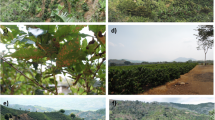Abstract
Most people in the Swat valley of northwest Pakistan practice subsistence farming, supplementing their income by collecting and selling wild harvested plants for use in herbal medicine. Previous work showed that the collectors did not know the potential long-term impacts of collecting wild plants. We hypothesized that establishment of ex situ cultivation plots for these most valuable species would provide a sustainable alternative and lead to development of skills in agricultural production and marketing among participants. Swat valley farmers were helped to establish plots in four locations and taught to cultivate ten medicinal and aromatic plants (MAPs). In the first year, workshops were held on the financial benefits of growing MAPs for trade, criteria in selecting species, and strategies to improve MAP yield. In the second year, emphasis was placed on helping the farmers achieve a better price for their products by engaging them in discussions concerning criteria used in setting purchase prices. Seven of the ten cultivated MAPs yielded a better financial return than tomatoes (Solanum lycopersicum L.), the traditional cash crop in the area. Cultivating MAPs can yield a higher financial return than traditional cash crops, but a long-term assessment is necessary. Offering training in collection, preservation, and marketing can enhance the financial return and the long-term benefits of cultivation. Introduction of standardized production technology and appropriate post-harvest management has become a prime engine of growth for the economies of the subsistence farmers participating in our study, and is leading to better management and conservation practices for MAPs and the landscapes in which they grow.

Similar content being viewed by others
References
Akerele O, Heywood VH, Synge H (1991) The conservation of medicinal plants: proceedings of an international consultation, 21–27 March 1988 held at Chiang Mai, Thailand. Cambridge University Press, Cambridge
Bodeker G (ed) (1997) Medicinal plants for forest conservation and health care. FAO, Rome
CITES (2014) The convention on international trade in endangered species of wild fauna and flora appendices
CPPR (2010) District Swat: socioeconomic baseline and displacement impact. Centre for Public Policy Research, Peshawar
Cunningham AB (1993) African medicinal plants: setting priorities at the interface between conservation and primary health care. People Plants Work Pap 1:1–50
FAO (2008) Trade in medicinal plants. In: Raw materials, tropical and horticultural products service commodities and trade division. Economic and Social Department. Food and Agriculture Organization of the United Nations, Rome
Farooquee NA, Saxena KG (1996) Conservation and utilization of medicinal plants in high hills of the central Himalayas. Environ Conserv 23:75–80
Kuipers SE (1997) Trade in medicinal plants. In: Bodeker G, Bhat KKS, Burley J, Vantomme P (eds) Medicinal plants for forest conservation and health care. Non-Wood Forest Products 11. FAO, Rome, pp 45–59
Lambert J, Srivastava J, Vietmeyer N (1997) Medicinal plants: rescuing a global heritage. World Bank Publications, Washington
Lange D (2002) Medicinal and aromatic plants: trade, production, and management of botanical resources. In: XXVI international horticultural congress: the future for medicinal and aromatic plants, vol 629, pp 177–197
PARC (2012) Annual report: plant sciences. Pakistan Agricultural Research Council, Islamabad
Schippmann U, Leaman DJ, Cunnningham AB (2002) Impact of cultivation and gathering of medicinal plants on biodiversity: global trends and issues. In: Biodiversity and the ecosystem approach in agriculture, forestry and fisheries. 9th regular session of the commission on genetic resources for food and agriculture. FAO, Rome, 12–13 October 2002, pp 1–21
Schippmann U, Leaman DJ, Cunningham AB (2006) A comparison of cultivation and wild collection of medicinal and aromatic plants under sustainability aspects. In: Bogers RJ, Craker LE, Lange D (eds) Medicinal and aromatic plants. Springer, Dordrecht, pp 75–95
Sher H (2013) Collection and marketing of high value medicinal and aromatic plants from district Swat, Pakistan. International Food Policy Research Institute (IFPRI), Washington
Sher H, Al-Yemeni M, Sher H (2010) Forest resource utilization assessment for economic development of rural community in northern parts of Pakistan. J Med Plants Res 4:1786–1789
Sher H, Aldosari A, Ali A, de Boer HJ (2014) Economic benefits of high value medicinal plants to Pakistani communities: an analysis of current practice and potential. J Ethnobiol Ethnomed 1:6
Shinwari ZK (2010) Medicinal plants research in Pakistan. J Med Plants Res 4:161–176
Srivastava J, Lambert J, Vietmeyer N (1996) Medicinal plants: An expanding role in development. World Bank Publications, Washington
WHO (2003) WHO guidelines on good agricultural and collection practices (GACP) for medicinal plants. World Health Organization, Geneva
Acknowledgments
We express our sincere thanks to USAID and the International Food Policy Research Institute (IFPRI) for their financial support. We are particularly grateful to Dr. David Orden, Senior Research Fellow in the Markets, Trade and Institutions Division of IFPRI, for sharing experiences and providing technical support and suggestions throughout the study and for his comments on initial drafts of this paper. We also thank Garrett Billings for preparing the map used.
Author information
Authors and Affiliations
Corresponding author
Ethics declarations
Conflict of interest
The authors declare that they have no conflict of interest.
Rights and permissions
About this article
Cite this article
Sher, H., Barkworth, M.E. & de Boer, H.J. Medicinal and aromatic plant cultivation in the Swat valley, north-western Pakistan, for economic development and biodiversity conservation. Genet Resour Crop Evol 64, 237–245 (2017). https://doi.org/10.1007/s10722-015-0346-z
Received:
Accepted:
Published:
Issue Date:
DOI: https://doi.org/10.1007/s10722-015-0346-z




